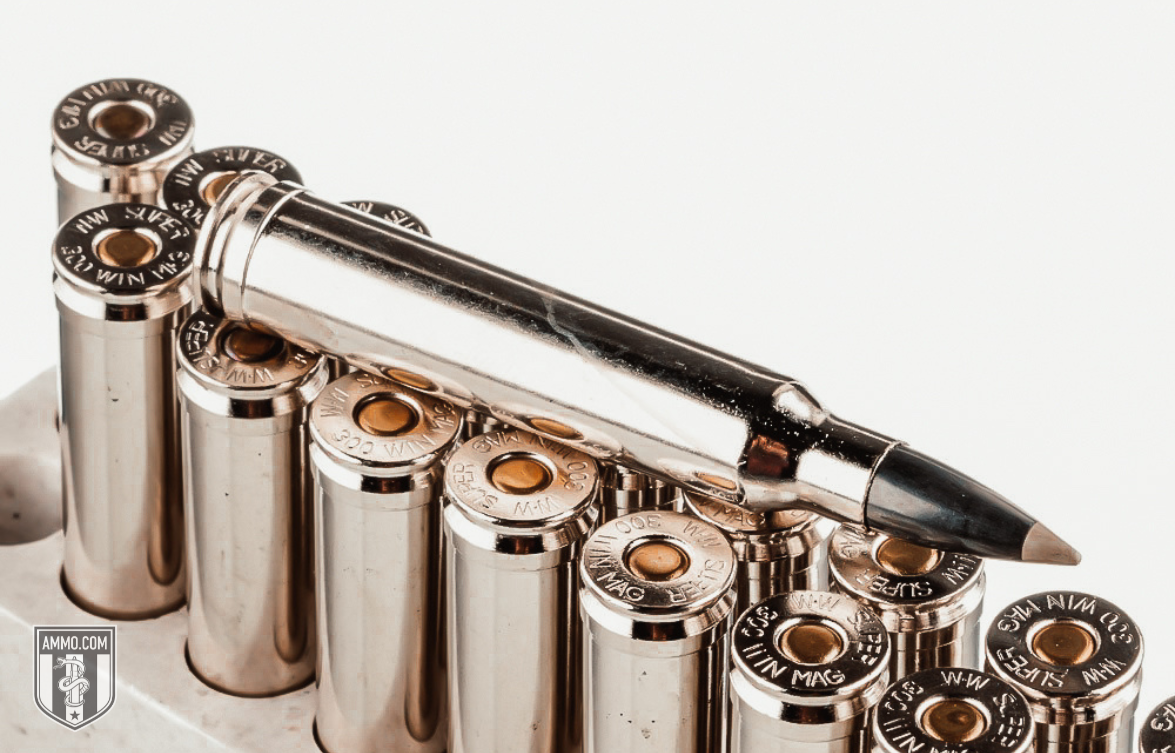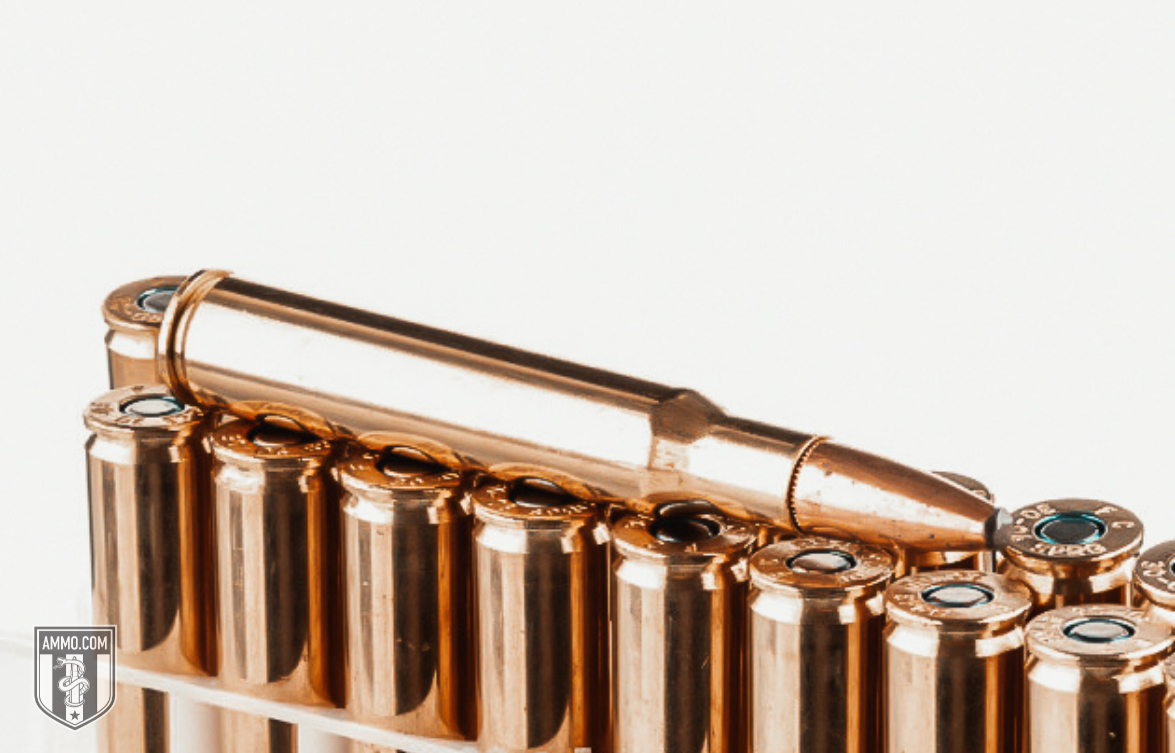300 Blackout vs. 300 Win Mag: Close-Range Cartridge vs.Long-Range Cartridge
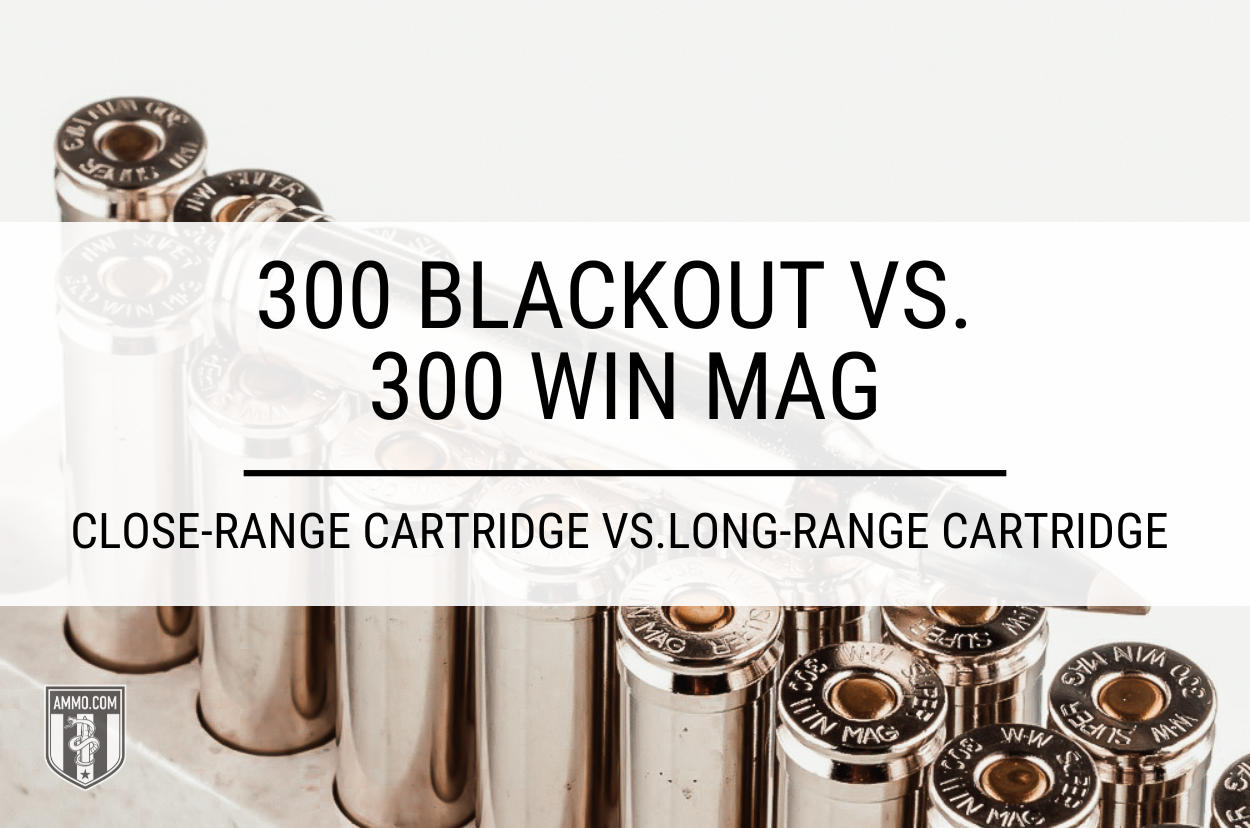 A comparison between 300 Blackout and 300 Win Mag can never be apples to apples. One was designed for shooting at close range; the other, for covering extremely long distances.
A comparison between 300 Blackout and 300 Win Mag can never be apples to apples. One was designed for shooting at close range; the other, for covering extremely long distances.
This article will help you decide if the 300 Winchester Magnum or 300 AAC Blackout is better for your situation.
Can I Shoot 300 Winchester Mag in a Rifle Chambered for 300 Blackout?
Heavens, no. You cannot fire a 300 Win Mag cartridge in a rifle chambered for 300 BLK. If you somehow (magically) managed to chamber a 300 Win Mag round in a 300 BLK rifle, you would only succeed at blowing the rifle to smithereens (and quite possibly your hands while you were at it).
Although the 300 Win Mag and 300 Blackout do have “300” in their names, they are vastly different from one another. Let’s examine why we’re comparing two genuinely incomparable cartridges.
Differences Between 300 Blackout and 300 Win Mag
If you compare the cartridges side by side, you’ll see that the 300 Win Mag is much longer. We’ll discuss the implications of this in greater detail below.
Another difference is their intended purpose. The 300 Blackout was designed for close-range combat scenarios, whereas the 300 Win Mag is intended for long-range big game hunting. These differences explain why each performs better in the situations discussed below.
With that in mind, let’s discuss cartridge specifications.
Cartridge Specs
Why do these two rounds share a “300” in their name? Because they each fire a .308” diameter bullet. They also have similar bullet weights (ranging from 110 grain to 220 grain for the 300 BLK and 110 grain to 250 grain for the 300 Win Mag) and neck diameters (0.334” for the 300 BLK and 0.339” for the 300 Win Mag). That’s pretty much where the similarities end.
The 300 Win Mag's base diameter is 0.532” – whopping, compared to the 300 BLK's 0.367”. The case length of the 300 Win Mag also dwarfs the 300 Blackout: 2.62” and 1.368”, respectively. Its case makes the 300 Winchester Magnum’s overall length substantially longer as well: 3.34”, as opposed to the 300 BLK at 2.26”.
The 300 BLK's smaller case translates into a much lower case capacity: 26.5 grains H2O, which is just more than one-quarter as voluminous as the 300 Win Mag’s 93.8 grains H2O. The 300 Win Mag’s substantially higher chamber pressure and recoil energy are predictable outcomes of this disparity.
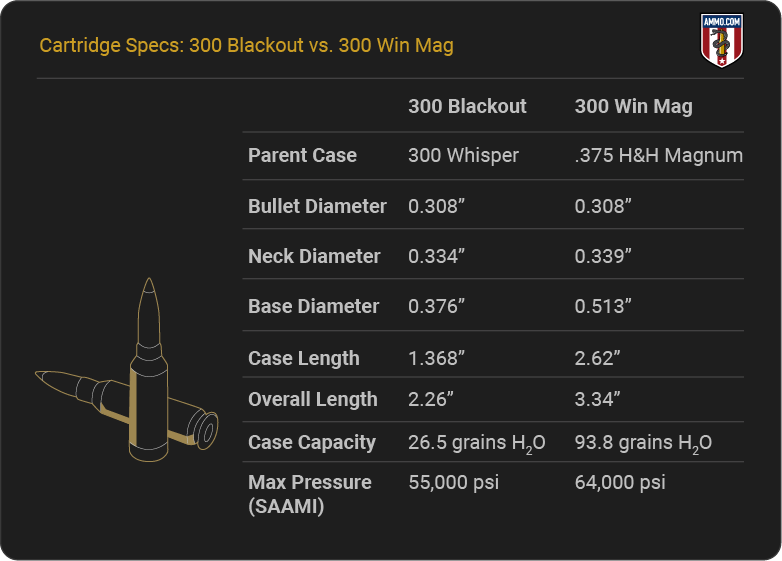
Recoil: 300 Win Mag vs. 300 Blackout
Several factors contribute to the amount of recoil a shooter experiences, including their stance, grip, and musculature. Fortunately, we can objectively measure recoil energy using only four variables: firearm weight, propellant charge weight, bullet weight, and muzzle velocity.
The 300 Win Mag has about 26 to 30 ft-lbs of recoil energy. This is on the higher end of recoil for rifle cartridges, but should be expected from a magnum. Be prepared for some serious shoulder thumping when you unleash a 300 WM.
The 300 AAC Blackout has a comparably paltry 6 ft-lbs of recoil energy, which isn’t too far off of the 5.56 NATO and 223 Remington. It’s barely noticeable, and substantially less than the .30 cal 308 Winchester as well.
For recoil-sensitive shooters (and those who enjoy keeping their shoulders socketed), the 300 Blackout is the better choice. We’re not saying the 300 Winchester Magnum’s recoil is totally unmanageable, but it does pack a heavyweight’s punch.
The 300 Blackout's welterweight recoil easily takes this section.
Trajectory
I like to consider the trajectories of any two rifle rounds I compare. It helps illustrate which one is better for specific scenarios. Trajectory doesn't matter quite so much in close-range situations, such as home defense or deer hunting within 200 yards. But when you’re covering long distances (e.g. the distances you are advised to keep between yourself and grizzly bears), a flatter trajectory is never a setback.
The 300 BLK was designed for engaging targets at close range (i.e. within 300 yards). It was also conceived as a subsonic cartridge (i.e. muzzle velocity lower than 1,125 fps), although it does boast a relatively flat trajectory out to (-52.7” at 400 yards following 100-yard zero) when it is loaded with a lightweight 110 grain V-MAX bullet.
On the other side of the spectrum lies the 300 Winchester Magnum. It was designed as a long-range hunting cartridge, so its trajectory is accordingly far flatter. When loaded with a heavier 220 grain OTM BT bullet and zeroed in at 200 yards, its trajectory drops a mere -42.08” at 500 yards.
The 300 Win Mag’s laser-like trajectory easily wins this section.
Accuracy: 300 AAC BLK vs. 300 Win Mag
A cartridge's accuracy is ultimately subjective, as it largely depends on the shooter, their perception of recoil, atmospheric conditions, ammunition selection, and whether a butterfly recently flapped its wings in Tokyo.
Many shooters find the 300 AAC Blackout to be more accurate due to its lower recoil. You’ll be less likely to develop bad habits (primarily flinching) when firing the 300 BLK.
The 300 Win Mag is more accurate at long range because of its flat trajectory. It requires fewer fine adjustments for windage, elevation and gravity than the 300 BLK, which greatly facilitates aiming.
This section is a draw. At close range, the 300 BLK will likely prove more accurate thanks to its gentler recoil recoil. At long range, the 300 Win Mag’s flat trajectory makes it much easier to hit precisely where you intend to.
Ballistic Coefficient
Ballistic coefficient (BC) is a numeric expression of a projectile’s aerodynamic efficiency and varies greatly from bullet to bullet. The higher the BC, the better the projectile will slice through the air and resist wind drift.
Both cartridges fire a .30 bullet in similar weights and designs, so their ballistic coefficients will be similar. However, the 300 Win Mag sometimes fires heavier bullets with a higher ballistic coefficient.
The 300 BLK uses bullets with a ballistic coefficient typically ranging from 0.267 to 0.393. The 300 Win Mag uses bullets with a ballistic coefficient typically ranging from 0.274 to 0.646.
The 300 Win Mag wins this section, as it fires longer, heavier projectiles with superior ballistic coefficients.
Stopping Power: 300 Blackout vs. 300 Win Mag
“Stopping power” is another subjective concept. Many shooters argue that the size of the hole matters more. Others emphasize how much energy the bullet can transfer to its target. But at the end of the day, neither assertion is worth a fig if you aren’t hitting your target.
Shot placement matters most. A well-placed small-caliber bullet is more effective than a big-bore yet poorly-aimed barn buster.
The 300 Blackout represents a drastic step up in stopping power from the 223 Rem or 5.56 NATO. Even so, the 300 Win Mag’s significantly higher muzzle velocity gives it a far, far harder wallop.
All things considered, the 300 Win Mag has more stopping power than the 300 Blackout.
Hunting
Despite being designed for combat, the 300 Blackout has found a place among deer, varmint and hog hunters who rarely fire beyond 200 yards.
The 300 Win Mag was designed for long-range big game hunting. It’s capable of taking down elk, moose, bear, and any other North American big game animal from 500+ yards away. It’s overkill on varmints, and will damage a lot of venison at close range.
The 300 Win Mag edges out the 300 BLK simply because it can hunt a wider variety of animals, but there are a few instances when the 300 BLK is the better option.
Home Defense: 300 Winchester Magnum vs. 300 AAC Blackout
I’m not a fan of using a rifle as a home defense weapon. I prefer a shotgun or a handgun for many reasons (primarily to lower the risk of over-penetration).
That said, if I were forced to choose between the 300 Win Mag and 300 AAC BLK for home defense, I would grab the 300 BLK in a heartbeat. Short-barreled rifles (SBRs) are often chambered in 300 BLK. With a suppressor, any one of them can deliver threat-stopping energy without deafening you in the process.
The 300 Win Mag is often chambered in bolt-action rifles, which is less than ideal for a home defense situation. It’s much more likely to punch a hole through your neighbor's refrigerator and continue down the block, however, which greatly increases the risk of striking an innocent bystander.
The 300 Blackout wins this section. It was designed for close-quarters combat (CQB). In contrast, a 300 Win Mag is only useful for combat when it’s placed in the hands of a sniper.
Ammo and Rifle Cost/Availability
We’re all limited by our budgets, so we often have to go with what’s most affordable. Let’s find out which cartridge will make a smaller hole – in your wallet.
300 Win Mag bolt-action rifles range from $500 to $4,000+. A good 300 Win Mag hunting rifle can be purchased for around $1,000. 300 Winchester Magnum ammo is also expensive.
At the time of writing, a 150 grain soft point deer hunting load costs around $1.80 per round. Premium ammo like Nosler Trophy Grade will cost you $4.25 per trigger pull. This isn’t a rifle you take to the range for a day of casual plinking!
The 300 AAC Blackout is similar in terms of rifle costs. The average price for a 300 BLK firearm is $500 to $2,500. 300 Blackout ammo is where you will save the most money, as it’s significantly less expensive (but not nearly so much as 5.56).
300 BLK 150 grain FMJ ammo costs about $0.90 per round, and premium loads like Barnes VOR-TX cost around $2 every time you pull the trigger. That’s less than half the cost of 300 Win Mag ammo, which makes it a much better option for a fun day at the gun range!
The 300 Blackout is the better option for shooters on a budget.
Reloading
Reloading is an excellent way to save money on ammunition. You can purchase your desired cartridges in bulk and reuse the spent brass to make handloads. Competition shooters and serious big game hunters fine-tune their handloads to achieve maximum performance out of their rifles.
The biggest downside to reloading is the initial cost. While purchasing reloading equipment and supplies can get expensive, it will save you money in the long run.
There is plenty of reloading information and supplies for the 300 Blackout and 300 Win Mag. I declare this section a tie.
300 Blackout vs. 300 Win Mag Ballistics
You'll love the ballistics chart below if you’re obsessed with numbers and want to see how a cartridge performs on paper. The team at Ammo.com has created easy-to-read charts to allow you to quickly compare each cartridge's ballistics.
300 Blackout Ballistics
Note: This information comes from the manufacturer. The actual ballistics obtained with your firearm can vary considerably from the advertised ballistics. Also, ballistics can vary from lot to lot with the same brand and type load.

Check out our article for a more in-depth look at 300 AAC Blackout ballistics.
300 Win Mag Ballistics
Note: This information comes from the manufacturer. The actual ballistics obtained with your firearm can vary considerably from the advertised ballistics. Also, ballistics can vary from lot to lot with the same brand and type load.
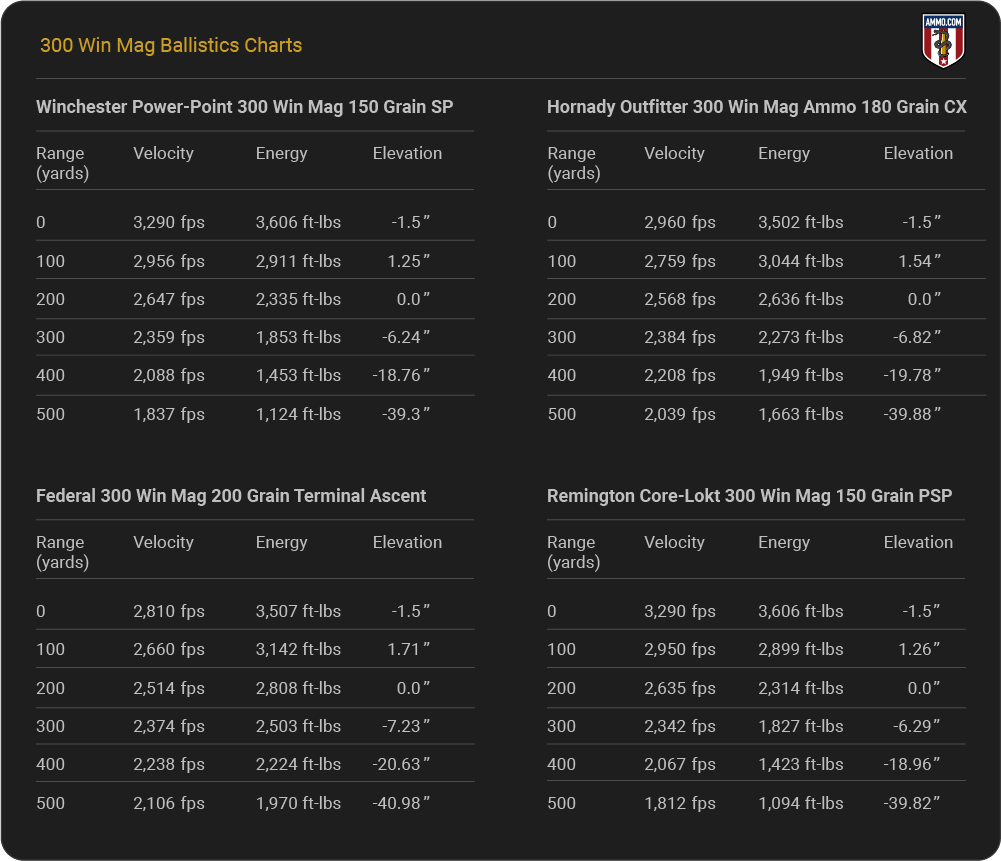
Check out our article for a more in-depth look at 300 Win Mag ballistics.
300 Blackout Ballistics Brief History
Advanced Armament Corporation developed the .300 AAC Blackout in 2010, offering a .30 caliber cartridge with better performance than the 5.56mm NATO. It is compatible with the M4. To fire a .300 AAC Blackout from a traditional M4, you just have to swap barrels.
Since its inception, it’s proven to be an excellent deer and hog hunting round. The .30 caliber bullet puts them down quickly without thumping the hunter’s shoulder. It’s capable of ethically harvesting deer out to 400-ish yards.
Despite being a relatively new cartridge compared to the 300 WM, the 300 BLK found favor among many enthusiasts. It’s not totally mainstream, but it’s not niche, either.
300 Win Mag Brief History
Since its introduction in the 1960s, the .300 Win Mag has developed a reputation for its ability to ethically harvest any North American game animal.
The popularity of the .300 Win Mag surged when the U.S. Army began converting 308 Win sniper rifles to fire it. This cartridge can engage human-sized targets out to 1,312 yards: about 50% farther than the .308 Winchester, which is a highly effective sniper rifle cartridge in its own right.
Competitive shooters have also found a place for the 300 Win Mag, as they cherish its flat trajectory during long-distance showdowns. I don’t foresee the 300 WM’s popularity waning anytime soon.
Parting Shots: 300 Blackout vs. 300 Win Mag
Congrats! You’ve made it to the end of the 300 Blackout vs. 300 Win Mag comparison. It’s time to tally up the sections and determine the winner for all eternity.
The 300 Blackout won three sections (recoil, home defense, and overall cost). The 300 Win Mag won four sections (trajectory, BC, stopping power, and hunting). Two sections were a draw (accuracy and reloading).
The 300 Win Mag edged out the 300 Blackout, but this comparison was fated to be a bit silly right from the start. Both cartridges are extraordinarily capable at handling situations they are actually intended for.
Don’t forget to check out our colossal ammo selection for both cartridges at Ammo.com!
Ammo Comparisons
- .308 vs 5.56
- 6.5 Creedmoor vs .308
- .300 Blackout vs .308
- .300 Win Mag vs .308
- .243 vs .308
- .308 vs .30-06
- 7mm-08 vs .308
- .270 vs .308
- 7.62x39 vs .308
- .223 vs .308
- .338 Lapua vs .308
- .380 ACP vs 9mm
- .223 vs 5.56
- .300 Blackout vs 5.56
- 9mm vs 45 ACP
- 9mm vs 40 S&W
- .357 SIG vs 9mm
- 10mm vs 9mm
- 9mm vs 9mm Luger
- .243 vs .270
- .300 Win Mag vs .30-06
- .270 vs .30-06
- .40 vs .45
- 38 Special vs 357
- 9mm vs 40 vs 45
- 5.56 vs 7.62x39
- 338 Lapua vs .30-06
- .30-30 vs .30-06
- 300 PRC vs 338 Lapua
- .30-06 vs 7mm
- 300 Win Mag vs 338 Lapua
- 300 PRC vs 300 Win Mag
- 300 WSM vs 300 Win Mag
- 338 Win Mag vs 338 Lapua
- 12 Gauge vs 20 Gauge
- 10mm vs 357 Mag
- .30-30 vs 7.62x39
- 224 Valkyrie vs 22-250
- 17 HMR vs 22 Mag
- 7.62x39 vs .300 Blackout
- 45 ACP vs 45 Auto
- 45-70 vs 30-30
- 300 Blackout vs 223
- 357 Magnum vs 9mm
- 350 Legend vs 300 Blackout
- 224 Valkyrie vs 223
- 45 ACP vs 38 Super
- 6.5 Grendel vs .308
- 17 HMR vs 22 LR
- 10 Gauge vs 12 Gauge
- 22-250 vs 223
- 45 Colt vs 45 ACP
- 350 Legend vs 30-30
- 5.7x28 vs 223
- 5.7 vs 9mm
- 5.56 vs 5.7
- 22 vs 9mm
- Buckshot vs Birdshot
- 450 Bushmaster vs 308
- 450 Bushmaster vs 223
- Buckshot vs Slug
- 6.5 Grendel vs 5.56 vs 223
- 6mm ARC vs 6.5 Grendel
- 44 vs 45
- 458 SOCOM vs 5.56
- 357 vs 44
- 32 ACP vs 380
- 300 Win Mag vs 338 Win Mag vs 338 Lapua Mag
- 450 Bushmaster vs 458 SOCOM vs 50 Beowulf
- 6mm Creedmoor vs 6.5 Creedmoor
- TMJ vs FMJ
- 44 Special Vs 44 Magnum
- 45 90 vs 45 70
- 6.8 Western vs 6.8 SPC
- 50 Beowulf vs 50 BMG
- 26 Nosler vs 6.5 PRC
- 28 Gauge vs 410
- 6.8 SPC vs 5.56
- 6.8 SPC vs 6.5 Grendel
- 6.8 Western vs 7mm Rem Mag vs .28 Nosler
- 6.8 Western vs 6.5 Creedmoor
- 22 Hornet vs 223
- 6.8 Western vs 6.5 PRC
- .410 vs 12 Gauge
- .410 vs 20 Gauge
- 22 LR vs 22 Mag
- 6mm ARC vs 243
- 7mm-08 vs 270
- 243 vs 6.5 Creedmoor
- Nickel vs Brass Casing
- 204 Ruger vs 223
- 50 Beowulf vs 5.56
- 260 Remington vs 6.5 Creedmoor
- 6mm Remington vs 243
- 28 Nosler vs 300 PRC
- 50 Beowulf vs 50 AE
- 22 Nosler vs 22-250
- 450 Marlin vs 45-70
- 300 Win Mag vs 300 Norma
- 458 SOCOM vs 300 Blackout
- 38-55 vs 45-70
- 22 Hornet vs 22 LR
- 300 Norma vs 338 Lapua
- 338 Lapua vs 50 BMG
- 28 Nosler vs 300 Win Mag
- 28 Nosler vs 6.5 Creedmoor
- 204 vs 22-250
- 458 SOCOM vs 45 70
- 44 40 vs 45 70
- 6.8 SPC vs 6.5 Creedmoor
- 450 Bushmaster vs 30-06
- 7mm Rem Mag vs 300 Win Mag
- 30 Carbine vs 223
- 25-06 vs 30-06
- 26 Nosler vs 28 Nosler
- 16ga vs 12ga
- 30 06 vs 7.62 x54R
- 9mm Makarov vs 9mm Luger
- 350 Legend vs 223
- 30 Carbine vs 5.56
- 6.5x55 vs 6.5 Creedmoor
- 6.5 Creedmoor vs 270 vs 25-06
- M193 vs M855
- 450 Bushmaster vs 458 SOCOM
- 6.5 Grendel vs 6.5 Creedmoor
- 350 Legend vs 5.56
- .277 Fury vs 6.8 SPC
- 277 Fury vs 300 Win Mag
- 10mm vs .45 ACP
- 277 Fury vs 223
- 6.8 SPC vs 300 Blackout
- 6.5 PRC vs 6.5 Creedmoor
- 277 Fury vs 308
- 277 Fury vs 6.5 Creedmoor
- 350 Legend vs 450 Bushmaster
- 277 Fury Vs 5.56 NATO
- 10mm vs 40S&W
- 32 ACP vs 9mm
- 32 Special vs 9mm
- 8.6 Blackout vs 300 Blackout
- 30 Super Carry vs. 9mm
- 5.56 vs 9mm
- .50 Action Express vs 9mm
- 7.62x25 vs. 9mm
- 10mm vs 44 Magnum
- 300 Blackout vs 300 Win Mag
- 6.5 Grendel vs 300 Blackout
- 460 Rowland vs 10mm
- 300 RUM vs 300 PRC
- 300 Norma vs 300 PRC
- 45 GAP vs 45 ACP
- 7mm PRC vs 300 Win Mag
- 300 PRC vs 6.5 Creedmoor
- 300 PRC vs 308
- 357 SIG vs 357 Mag
- 7.62x39 vs 7.62x51
- 243 Win vs 223 Rem
- 30 Nosler vs 300 PRC
- 6.5 Creedmoor vs. 30-06 Springfield
- 450 S&W vs. 44 Magnum
- 6.5 Creedmoor vs. 300 Win Mag
- 454 Cassull vs. 45-70 Govt
- 454 Cassull vs. 44 Mag
- 7.62x54r vs. 308 Winchester
- 22 ARC vs. 223 Rem
- Subsonic vs. Supersonic Ammo

